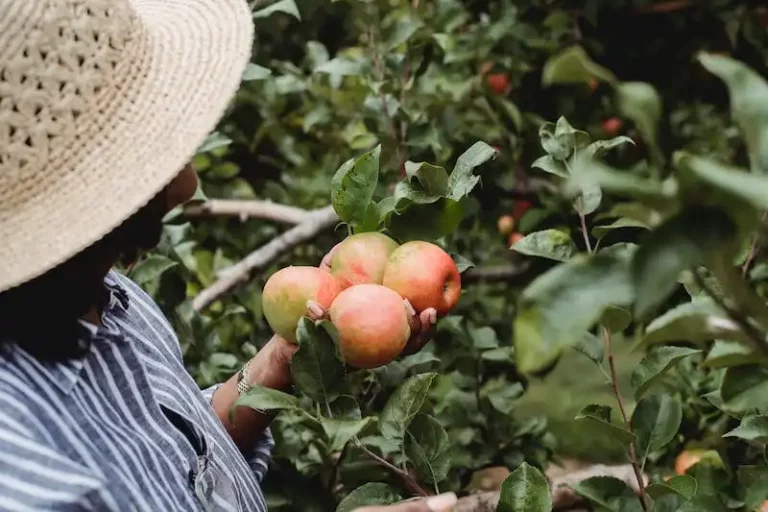Spring is the perfect time to start growing your own organic herbs in the backyard. These herbs not only add a touch of beauty to your garden but also provide a wide range of health benefits. Let’s take a look at five springtime herbs that are known for their cleansing properties.
1. Lavender: Known for its soothing fragrance, lavender is a must-have herb in every garden. Its flowers can be used to make soothing teas, sauces, and even homemade skincare products. Plus, it attracts bees and butterflies, adding movement and vitality to your garden.
2. Cleavers: Cleavers, also known as “sticky weed,” is a versatile herb that can be eaten raw or cooked. Its stems and leaves are used in herbal medicine to reduce swelling and promote lymphatic movement. This herb is a favorite among foraging enthusiasts.
3. Chickweed: Chickweed is a fast-growing herb that thrives in the cool spring weather. Its delicate leaves make a perfect addition to salads, while its stems can be used in soups and stews. This herb is known for its detoxifying properties and is often used to cleanse the body.
4. Nettles: Nettles are a common herb found in many gardens. This seasonal herb is best harvested in the spring when the young leaves are at their peak. Nettles are rich in vitamins and minerals and are known for their ability to cleanse the blood and boost vitality.
5. Bellis Perennis (English Daisy): This herb is often found in lawns and open sunny areas. Its flowers are edible and can be used as a garnish or added to salads. English daisies are known for their soothing properties and have been used medicinally for centuries.
Now is the perfect time to start growing these springtime herbs in your garden. Their healthy and cleansing properties will not only benefit you and your family, but they will also attract bees and butterflies, creating a thriving ecosystem in your backyard. So, get your hands in the soil, plant these herbs, and enjoy the beauty and health benefits they bring to your garden.
10 great herbs to start from seed this spring season
If you’re looking to add some fresh herbs to your garden this spring, starting from seed is a cost-effective and rewarding option. Here are 10 great herbs that you can easily grow from seed:
| Herb | Description |
| Cleavers | These wild herbs are known for their detoxifying properties and can be used in teas and tonics. |
| Chives | Chives are a great addition to any dish, adding a mild onion flavor. |
| Dandelion | The yellow flowers of the dandelion plant can be used to make dandelion wine or infused oil. |
| Mint | Mint is a refreshing herb that can be used in both sweet and savory dishes. It can also be used to make delicious mint tea. |
| Thyme | Thyme is a versatile herb that is often used in Mediterranean cooking. It adds a fragrant touch to any dish. |
| Urtica | Also known as stinging nettle, urtica has many health benefits and can be used in soups, smoothies, and tonics. |
| Horsetail | Horsetail is a unique herb with a high concentration of silica. It can be used to promote healthy hair and nails. |
| Basilicum | Basilicum, or basil, is a classic herb that is essential in many Italian dishes. It can also be used to make delicious pesto. |
| Taraxacum | Also known as dandelion, taraxacum is a versatile herb that can be used in salads, teas, or even roasted as a coffee substitute. |
| Melissa | Also known as lemon balm, melissa has a citrusy flavor and is often used to make herbal tea or infused oil. |
These herbs can be grown from seed directly in your garden or started indoors and transplanted once the weather warms up. Make sure to give them plenty of sunlight and medium-moisture soil for optimal growth. With the right care, you’ll have a lush herb garden in no time!
Basil
Basil, scientifically known as Ocimum basilicum, belongs to the mint family. It is an aromatic herb widely used in various cuisines around the world for its culinary and medicinal properties. Basil is native to warm regions like India, Africa, and Southeast Asia, but it can be grown in many climates.
In the springtime, basil can be planted outdoors once the threat of frost has passed. It requires well-drained soil and a sunny location. Basil plants are usually grown from seeds, and they require a spacing of about 12 to 18 inches apart. When planting basil, it’s a good idea to provide some support for the plants as they grow.
Basil is an evergreen plant that produces an abundance of flavorful and fragrant leaves. It can be harvested throughout the growing season, and regular harvesting will encourage more growth. The leaves can be used fresh or dried for various purposes.
Basil has many culinary uses and is often found in dishes like pesto sauces, soups, pasta, and salads. It pairs well with tomatoes, onions, garlic, and other herbs like oregano and thyme. Basil also has medicinal properties and is known for its antioxidant and antibacterial effects.
When it comes to health benefits, basil is a superfood. It is rich in essential nutrients like vitamin K, vitamin A, iron, calcium, and magnesium. It has been used in traditional medicine to aid digestion, reduce inflammation, and promote heart health.
Aside from its culinary and medicinal uses, basil also has some surprising properties. Ingesting basil leaves can help to repel mosquitoes, and it can also be used as a natural remedy for coughs and colds. Basil can even be used as a beauty ingredient for skin and hair care.
In summary, basil is a versatile herb that adds flavor and aroma to a wide range of dishes. It can be grown in the garden or in containers, making it suitable for both backyard gardens and small spaces. With its numerous health benefits and culinary uses, basil is a must-have herb for any herb garden or kitchen.
Rosemary
Rosemary is a versatile herb that is commonly used in cooking, but it also has many other benefits. This aromatic herb not only adds great flavor to dishes, but it also makes a beautiful addition to any garden.
Rosemary is a perennial herb that loves the sun and thrives in well-drained soil. It is a woody herb with needle-like leaves that grow in an upright habit. The grey-green foliage adds a touch of elegance to any garden. In addition to its ornamental value, rosemary is also a great pollinator plant, attracting bees and butterflies to your garden.
But rosemary is not just a pretty plant. It has many medicinal properties as well. For centuries, rosemary has been used in traditional medicine to improve memory and concentration. It has also been used to relieve muscle pain, stimulate hair growth, and improve digestion. Rosemary oil is commonly used in aromatherapy to promote relaxation and reduce stress.
One of the easiest ways to enjoy the benefits of rosemary is to grow it in your own garden. Rosemary is a hardy herb that can tolerate a wide range of growing conditions. It is drought-tolerant and can be grown in both containers and in the ground. It is best planted in a sunny spot with well-drained soil.
To harvest rosemary, simply clip off a sprig or two as needed. Fresh rosemary can be used in a variety of dishes, from roasted meats and vegetables to soups and sauces. If you have more rosemary than you can use, you can dry it for later use or make a rosemary tincture.
Whether you are a seasoned gardener or a beginner, rosemary is a great herb to have in your garden. It not only adds beauty and fragrance, but it also has many practical uses. So why not give it a try and see what wonders rosemary can do for you?
Cilantro
Cilantro, also known as Coriandrum sativum, is a popular herb with a strong flavor. This herb is often used in various cuisines to add a fresh and tangy taste to dishes.
Cilantro is a great herb to grow in your garden because it is easy to cultivate and has many health benefits. It is rich in phyto-nutrients and antioxidants that can help cleanse the liver and improve digestion.
Cilantro can be grown from seeds or seedlings. It is a cool weather herb and is best to plant it in late spring. It requires ample sunlight to grow above the ground, but it can also tolerate some shade.
When growing cilantro, it is important to note that it does not like to be transplanted. Therefore, it is better to sow the seeds directly into the soil where they will grow. Cilantro can self-seed, meaning that it will drop its seeds and grow again the following season.
This herb prefers well-draining soils and needs to be watered regularly. It is important to keep the soil moist, but not waterlogged. Over-watering can cause root rot and other diseases. Cilantro likes cool temperatures, so it will bolt and go to seed when the weather gets too hot.
Cilantro leaves are commonly used in cooking. They have a unique taste that can vary from person to person. Some people describe it as citrusy, while others may find it soapy. Regardless of the flavor, cilantro can add a refreshing touch to salads, soups, and marinades.
In addition to its culinary uses, cilantro has also been used for centuries in traditional medicine. It is believed to have detoxifying properties and can be used to help cleanse the body. Cilantro is also thought to have anti-inflammatory and antibacterial effects.
In conclusion, cilantro is a versatile herb that can be grown easily in your garden. Its unique flavor and health benefits make it a great addition to your culinary and medicinal activities. Whether you enjoy it in fresh salads or use it to create your own tonics, cilantro is sure to be a favorite herb in your springtime garden.
Peppermint
Peppermint is a sprawling herb with grey-green stems and stinging purple flowers. Peppermint is a common herb found outside in yards and gardens. It is a medium-moisture herb that can withstand snow and cold temperatures while still maintaining its health.
Peppermint is known for its fragrant aroma and cooling properties. The leaves can be taken fresh or dried and used in a variety of dishes, teas, and tinctures. Peppermint is also a soothing herb that can be used to ease digestive discomfort and calm the stomach.
Peppermint is closely related to other herbs like spearmint and watermint. It is a member of the Ocimum family. Peppermint has active compounds that promote a healthy liver and aid in cleansing the body. It is also known for its anti-inflammatory properties.
Peppermint can be propagated through its root cuttings or by planting seeds. It is a fast-growing herb that will start sprouting once the springtime comes. Peppermint can be grown outdoors throughout the seasons and harvested year-round.
Peppermint is a versatile herb that can be used in various ways. It can freshen breath, alleviate headaches, and relieve muscle tension. Peppermint also makes a great addition to homemade cleaning products and can be used to repel insects.




